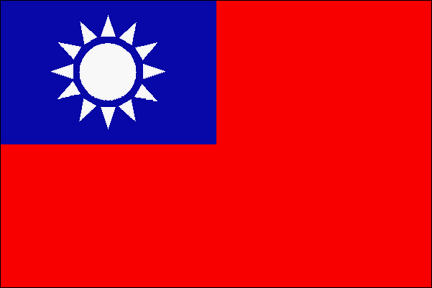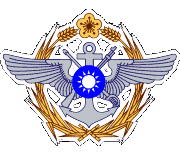



Ministry of National Defense
 Article 36 of the ROC Constitution stipulates that the president of the republic "shall have supreme command of the land, sea and air forces of the whole country," and Article 3 of the Organic Law of the Executive Yuan states that "the Executive Yuan shall establish (among others) a Ministry of National Defense." According to the Organization Law of the MND , the ministry shall be in charge of the defense affairs of the whole country, and the minister shall be a civilian. The current defense minister is Chiang Chung-ling .
Within the Ministry of National Defense is the General Staff Headquarters (GSH), under which are the various services, including the Army, Navy, Air Force, Combined Services Forces, Armed Forces Reserve Command/Coast Guard Command, and Military Police Command. In charge of military affairs, the GSH is headed by a chief of the general staff, who acts, in the military command system, as chief of staff to the president for operational matters; while in the administrative system, he serves as chief of staff to the minister of national defense. The current chief of the general staff is General Lo Pen-li .
The Ministry of National Defense is responsible for formulating military strategy, setting military personnel policies, devising draft and mobilization plans, delineating supply distribution policies, arranging for the research and development of military technology, compiling data for the national defense budget, setting military regulations, conducting court martial proceedings and administering military law. The ministry itself has a Minister's Office ; Departments of Manpower , Materials , and Law ; a Bureau of the Comptroller , and the Judge Advocates Bureau .
Article 36 of the ROC Constitution stipulates that the president of the republic "shall have supreme command of the land, sea and air forces of the whole country," and Article 3 of the Organic Law of the Executive Yuan states that "the Executive Yuan shall establish (among others) a Ministry of National Defense." According to the Organization Law of the MND , the ministry shall be in charge of the defense affairs of the whole country, and the minister shall be a civilian. The current defense minister is Chiang Chung-ling .
Within the Ministry of National Defense is the General Staff Headquarters (GSH), under which are the various services, including the Army, Navy, Air Force, Combined Services Forces, Armed Forces Reserve Command/Coast Guard Command, and Military Police Command. In charge of military affairs, the GSH is headed by a chief of the general staff, who acts, in the military command system, as chief of staff to the president for operational matters; while in the administrative system, he serves as chief of staff to the minister of national defense. The current chief of the general staff is General Lo Pen-li .
The Ministry of National Defense is responsible for formulating military strategy, setting military personnel policies, devising draft and mobilization plans, delineating supply distribution policies, arranging for the research and development of military technology, compiling data for the national defense budget, setting military regulations, conducting court martial proceedings and administering military law. The ministry itself has a Minister's Office ; Departments of Manpower , Materials , and Law ; a Bureau of the Comptroller , and the Judge Advocates Bureau .
General Staff Headquarters, MND
In charge of the planning and supervision of joint war activities, political warfare, personnel, military intelligence, operations, education and training, logistics, organization and equipment calibration, communications, military archives management, and medical services, the General Staff Headquarters, MND contains the Office of the Chief of the General Staff ; the Department of Supervision and Inspection ; the General Political Warfare Department ; Offices of the Deputy Chiefs of the General Staff for Personnel , Intelligence , Operations , Logistics , and Planning ; the Bureau of Communications and Electronics ; the Military History and Translation Bureau ; the Military Medical Bureau ; and the General Affairs Bureau .
Combined Services Force General Headquarters
The Combined Services Force General Headquarters is in charge of ordinance, military maps, and communication equipment for the ROC Armed Forces. It also provides support and services commonly needed by all Armed Forces services, such as finance, surveying, engineering, rear echelon administration, purchase and procurement, and armament appraisal and testing.
Armed Forces Reserve Command
Shortly after the ROC government announced the lifting of the Emergency Decree and the termination of the Period of National Mobilization for Suppression of the Communist Rebellion , the Taiwan Garrison General Headquarters (TGGH) was deactivated, and two new commands were created to assume partial responsibility for tasks formerly performed by the TGGH: the Armed Forces Reserve Command (AFRC), which is mainly in charge of reservist management and mobilization affairs; and the Coast Guard Command (CGC), responsible for matters of coastal security.
Manpower Structure
A person in the ROC military may be an officer , a noncommissioned officer (NCO) , or an enlisted man . He may be serving on either a volunteer or a conscript basis, and may be on active duty or reserve status.
Officers
Officers in the ROC military generally come from three backgrounds. They might be graduates of military academies who become career officers , graduates of different specialized military schools who serve shorter terms of duty , or college graduates who have passed a written test to become reserve officers.
Approximately 15 percent of the officers commissioned each year are graduates from different military academies; another 45 percent are graduates of specialized military schools; and the remaining 40 percent are reserve officers.
The ratio of officers to NCOs is currently 1:2.4, while that to enlisted men is 1:2.6. Thus, the ratio of officers to soldiers as a whole in the ROC Armed Forces is around 1:5, which is close to the 1:6 ratio of the US Armed Forces, and almost equals that of the Japanese Self-Defense Force (1:4.98).
Noncommissioned Officers
NCOs constitute the backbone of basic units of the Armed Forces, and are increasingly depended upon to train troops and develop their combat performance. In recent years, however, most senior NCOs have retired, leaving the current proportion of career NCOs too low and the percentage of NCO reservists in service too high. Reservists are on active duty for a very limited period of time, making it difficult for them to keep up with changes in the operation and maintenance of ever-more sophisticated weapons and equipment. Solutions to this problem lie in reconfiguring the NCO organizational structure and recruiting new NCOs.
Conscripts
The Military Service Law of the ROC stipulates that all males in the Republic of China shall fulfill military service. Article 3 of the law states: "Male persons shall be liable for military service on January 1 of the year immediately following the year during which they reach the age of 18, and shall no longer be drafted for service beginning on December 31 of the year during which they reach the age of 45." Citizens who have been sentenced to imprisonment for longer than seven years are prohibited from entering the military.
Under the Military Service Law, military conscription is administered jointly by the Ministry of National Defense and the Ministry of the Interior . The former is responsible for securing an adequate number of conscripts and training them, while the latter determines the sources of the conscripts and ensures their rights and benefits. Generally, conscripts undergo a minimum of two months of basic training before receiving their 22-month unit assignments.
Male senior high, vocational high, and college students whose studies would be interrupted by military conscription can defer their induction until after graduation. Students who are admitted to a university or college undergo two months of basic training in the summer before their freshman year. Upon graduation, they re-enter the military to fulfill the remainder of their two-year commitment.
Young men in poor health are exempt from military conscription. Those in average health may serve in the National Guard . Draftees from impoverished families may apply for service in this unit, giving them reserve status and allowing them to stay with their families. In addition, the only son of parents who are over seventy may also apply for National Guard service to fulfill his military obligation.
Military Mobilization
The ROC defense strategy calls for maintaining a minimum force in peacetime and mobilizing a large number of troops in the event of war. The reservist system plays a key role in such a policy by facilitating instantaneous mobilization and instant combat readiness. At present, registered reservists in the ROC amount to about 3.8 million persons, or more than 18 percent of the general population. After a man is discharged from active duty, he must report to his local military reserve unit, a subunit under the Armed Forces Reserve Command. Reservists are organized into different units according to their military occupational specialty (MOS). Since a prolonged mobilization recall might adversely affect both the livelihood of a reservist and the overall economic development of the country, annual reservist training is usually conducted through recalls. An MOS refresher training course is conducted, and each reservist is notified of his unit combat mission and relative location.
Defense R&D
Research and development of national defense technology is often in direct proportion to the degree of a nation's industrialization. While the ROC industrial sector has made considerable progress over the past decade, most of it has in fact been confined to machining components and light manufacturing. The MND has long made use of the National Defense Industrial Development Fund to assist public and private enterprises in cultivating qualified technical personnel and purchasing facilities, transferring advanced technology, and developing a more sophisticated production base that one day promises a fully self-reliant defense industry. The MND has issued the Defense Science and Technology Development Plan to strengthen cooperation between the academic and industrial sectors, and has, along with several cabinet-level institutions such as the National Science Council , the Ministry of Education , and the Ministry of Economic Affairs , set up the Executive Committee for the Development of Defense Science and Technology (ECDDST). With its two subdivisions, the Academic Cooperation Group and the Industrial Cooperation Group , the ECDDST taps academic resources for researching defense technology and makes use of the industrial sector to develop and manufacture weaponry and armaments.
Chungshan Institute of Science and Technology
As the leading institution for the research, development, and design of defense technology in the ROC, the Chungshan Institute of Science and Technology (CIST) contains some 6,000 scientists and more than 8,000 technicians.
With its headquarters in Lungt'an , Taoyuan County, the CIST has facilities stretching over nearly 6,000 acres scattered throughout Taiwan, and is divided into four major research divisions: aeronautics, missiles and rockets, electronics, and chemistry. The CIST has six centers for systems development, systems maintenance, quality assurance, materials R&D, aeronautic development, and missile manufacturing. Each research division or research center has a director in charge of the research and development of its specialty, while planning units have project chairmen responsible for R&D program management and system integration. The CIST jointly conducts independent research and development of weapon systems with the Aero Industry Development Center , which is now under CIST supervision; some manufacturing units of the Combined Services Force; academic institutions; and public and civilian industries.
To date, a number of weapon systems have been domestically designed, tested, and produced on a mass scale by the CIST. These include the Kung-feng 6A rocket, the Hsiung-feng I and Hsiung-feng II SAMs, artillery fire control systems, naval sonar systems, naval electronic warfare systems, and the Tzu-chiang trainer aircraft . The CIST has produced or plans to produce Tien-kung I and Tien-kung II SAMs, and Tien-chien AAMs. The institute is also developing the Tien-chien II AAM system. To date, the first squadron of 20 prototype IDF fighters has been completed and turned over to the ROC Air Force.
A proposal to privatize the Aero Industry Development Center was approved by the Legislature on May 16, 1995. This conversion from military to private status, under the supervision of the Ministry of Economic Affairs, is intended to facilitate the transfer of ROC military aeronautic know-how to the private sector while enabling the center to form joint ventures with high-tech foreign manufacturers. This in turn is expected to bring advanced aviation technology into Taiwan to accelerate the growth of the nation's aerospace industry. A period of three-and-a-half years has been granted to the center to carry out full privatization.
Sources and Resources
http://www.fas.org/irp/world/taiwam/mnd.htm
Created by John Pike
Maintained by Steven Aftergood
Updated Friday, September 15, 2000 1:46:44 PM






 Article 36 of the ROC Constitution stipulates that the president of the republic "shall have supreme command of the land, sea and air forces of the whole country," and Article 3 of the Organic Law of the Executive Yuan states that "the Executive Yuan shall establish (among others) a Ministry of National Defense." According to the Organization Law of the MND , the ministry shall be in charge of the defense affairs of the whole country, and the minister shall be a civilian. The current defense minister is Chiang Chung-ling .
Within the Ministry of National Defense is the General Staff Headquarters (GSH), under which are the various services, including the Army, Navy, Air Force, Combined Services Forces, Armed Forces Reserve Command/Coast Guard Command, and Military Police Command. In charge of military affairs, the GSH is headed by a chief of the general staff, who acts, in the military command system, as chief of staff to the president for operational matters; while in the administrative system, he serves as chief of staff to the minister of national defense. The current chief of the general staff is General Lo Pen-li .
The Ministry of National Defense is responsible for formulating military strategy, setting military personnel policies, devising draft and mobilization plans, delineating supply distribution policies, arranging for the research and development of military technology, compiling data for the national defense budget, setting military regulations, conducting court martial proceedings and administering military law. The ministry itself has a Minister's Office ; Departments of Manpower , Materials , and Law ; a Bureau of the Comptroller , and the Judge Advocates Bureau .
Article 36 of the ROC Constitution stipulates that the president of the republic "shall have supreme command of the land, sea and air forces of the whole country," and Article 3 of the Organic Law of the Executive Yuan states that "the Executive Yuan shall establish (among others) a Ministry of National Defense." According to the Organization Law of the MND , the ministry shall be in charge of the defense affairs of the whole country, and the minister shall be a civilian. The current defense minister is Chiang Chung-ling .
Within the Ministry of National Defense is the General Staff Headquarters (GSH), under which are the various services, including the Army, Navy, Air Force, Combined Services Forces, Armed Forces Reserve Command/Coast Guard Command, and Military Police Command. In charge of military affairs, the GSH is headed by a chief of the general staff, who acts, in the military command system, as chief of staff to the president for operational matters; while in the administrative system, he serves as chief of staff to the minister of national defense. The current chief of the general staff is General Lo Pen-li .
The Ministry of National Defense is responsible for formulating military strategy, setting military personnel policies, devising draft and mobilization plans, delineating supply distribution policies, arranging for the research and development of military technology, compiling data for the national defense budget, setting military regulations, conducting court martial proceedings and administering military law. The ministry itself has a Minister's Office ; Departments of Manpower , Materials , and Law ; a Bureau of the Comptroller , and the Judge Advocates Bureau .
